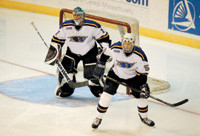Sigma's 120-300mm f/2.8 APO HSM Zoom Lens
Killer Long Zoom At An Attractive Price
Long, fast, good lenses are
expensive. They're also worth it. Whether you shoot sports, live
performances, wildlife, people, or just need to reach out into the distance
for that perfect shot, a really good telephoto lens is a must. |
|||
Smaller
And Lighter In The Field |
|||
The Sports Arena |




































